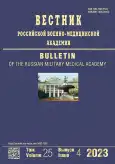Frequency and causes of blood chimera in combat trauma victims
- Authors: Tsygankov К.A.1, Gorban D.Y.1, Lakhin R.E.1, Shchegolev A.V.1, Savelyeva L.P.1, Konoshenko P.P.2
-
Affiliations:
- Kirov Military Medical Academy
- 32-Separate Medical Detachment (airmobile)
- Issue: Vol 25, No 4 (2023)
- Pages: 629-635
- Section: Original Study Article
- Submitted: 26.08.2023
- Accepted: 09.10.2023
- Published: 25.12.2023
- URL: https://journals.eco-vector.com/1682-7392/article/view/568839
- DOI: https://doi.org/10.17816/brmma568839
- ID: 568839
Cite item
Abstract
The frequency and causes of blood chimeras in victims of combat trauma who arrived from special military operations were analyzed. Data from immunohematological studies of patients admitted to the clinics of the Military Medical Academy named after S. M. Kirov in the period from February to December 2022 were analyzed. All patients were assessed for blood group membership by AV0 systems and Rh factor with phenotyping of erythrocytes and the presence of antierythrocyte antibodies. Chimerism was found in 21% of the patients. According to the AB0 system, general chimerism was detected in 3. 1% of cases, whereas blood chimerisms for antigens A and B were found in 81. 8% and 36. 4% of the cases, respectively. Moreover, blood chimerism for antigens C, c, E, and e was detected in 100% of the cases, and for antigen D, the rate of chimerism was 7. 6%. The identified chimerism in the patients was caused by the use of “universal” doses of erythrocyte blood components by advanced medical service units. In general, the frequency of blood chimerism in victims of combat trauma in the clinics of the Military Medical Academy named after S. M. Kirov was 21%. Blood chimerism in combat trauma victims did not lead to significant immunization. Despite the absence of detected immunization, blood chimerism was a favorable background for possible hemolytic posttransfusion complications during treatment. Possible options for the prevention of blood chimerism include the introduction into practice of advanced use of artificial oxygen carriers, active use of hardware support for reinfusion of blood spilled into the cavity, and preparation of autokrovi for certain patients. These measures are aimed at reducing the number of transfusions of donor blood components, thereby preventing the formation of antierythrocyte antibodies and blood chimeras.
Full Text
About the authors
Кirill A. Tsygankov
Kirov Military Medical Academy
Author for correspondence.
Email: doctorcygankov@mail.ru
ORCID iD: 0000-0002-2357-0685
SPIN-code: 7133-0503
MD, Cand. Sci. (Med.)
Russian Federation, Saint PetersburgDenis Yu. Gorban
Kirov Military Medical Academy
Email: doctorcygankov@mail.ru
residency student
Russian Federation, Saint PetersburgRoman E. Lakhin
Kirov Military Medical Academy
Email: doctor-lahin@yandex.ru
ORCID iD: 0000-0001-6819-9691
SPIN-code: 7261-9985
MD, Dr. Sci. (Med.)
Russian Federation, Saint PetersburgAleksey V. Shchegolev
Kirov Military Medical Academy
Email: alekseishegolev@gmail.com
SPIN-code: 4107-6860
MD, Dr. Sci. (Med.), Professor
Russian Federation, Saint PetersburgLidiya P. Savelyeva
Kirov Military Medical Academy
Email: doctorcygankov@mail.ru
Head of the laboratory
Russian Federation, Saint PetersburgPavel P. Konoshenko
32-Separate Medical Detachment (airmobile)
Email: doctorcygankov@mail.ru
Head of the surgical Department
Russian Federation, AnapaReferences
- Kronstedt S, Lee J, Millner D, et al. The role of whole blood transfusions in civilian trauma: A review of literature in military and civilian trauma. Cureus. 2022;14(4):e24263. doi: 10.7759/cureus.24263
- Trishkin DV, Kryukov EV, Chuprina AP, et al. Metodicheskie rekomendatsii po lecheniyu boevoi khirurgicheskoi travmy. Moscow: GVMU MO RF; 2022. 373 р. (In Russ.).
- Lantry JH, Mason P, Logsdon MG, et al. Hemorrhagic resuscitation guided by viscoelastography in far-forward combat and austere civilian environments: goal-directed whole-blood and blood-component therapy far from the Trauma Center. J Clin Med. 2022;11(2):356. doi: 10.3390/jcm11020356
- Dunne JR, Lee TH, Burns C, Cardo LJ, et al. Transfusion-associated microchimerism in combat casualties. J Trauma. 2008;64(2 Supple): discussion S92–S98. doi: 10.1097/TA.0b013e318160a590
- Reed W, Lee TH, Norris PJ, et al. Transfusion-associated microchimerism: a new complication of blood transfusions in severely injured patients. Semin Hematol. 2007;44(1):24–31. doi: 10.1053/j.seminhematol.2006.09.012
- Wang Y, Mou Q, Lei H, et al. Molecular biology analysis of ABO blood group variants caused by natural chimaerism. Vox Sang. 2022;117(11):1310–1317. doi: 10.1111/vox.13356
- Gaiduk SV, Ovchinnikov YuV, Khalimov YuSh, Gaiduk VA. Cardio-respiratory pathology in wounded in counter-terroristic operation in Chechny. Bulletin of the Russian Military Medical Academy. 2016;53(1):22–28. (In Russ.).
- Esipov AV, Sukhorukov AL, Musailov VA, et al. Value and structure of isolated limb injuries in modern local conflicts (literature review). Military Medical Journal. 2023;344(3):33–39. (In Russ.). doi: 10.52424/00269050_2023_344_3_33
- Kunitsky YuL, Grintsov AG, Kharkovsky VA, et al. Features of battle trauma during the local armed conflict in donbas. Vestnik Neotlozhnoi i Vosstanovitel’noi Khirurgii. 2019;4(3):47–50. (In Russ.).
- Beschastnov VV. Features of nato’s soldiers limbs combat trauma treatment during armed conflicts on the territory of iraq and afghanistan (literature review). Rany i ranevye infektsii. Zhurnal im. prof. Kostyuchenka. 2021;3(8):6–10. (In Russ.). doi: 10.25199/2408-9613-2021-8-3-6-10
- Krainyukov PE, Denisov AV, Logatkin SM, et al. Peculiarities of gunshot injury in military personnel protected by bulletproof vest, determining the tactics of providing medical care. Military Medical Journal. 2020;341(9):4–12. (In Russ.). doi: 10.17816/RMMJ82343
- Pertsev DA, Ryzhikov MA, Maidan VA. assessment of compatibility of personal protective equipment for hearing organs with elements of military equipment. Izvestia of the Russian Military Medical Academy. 2019;38(S 1–2):62–65. (In Russ.).
- Valetova VV, Ermolov AS, Timerbaev VKh, Dragunov AV. Influence of intraoperative infusion-transfusion therapy on the lethality of patients with massive blood loss. Russian Journal of Anaesthesiology and Reanimatology. 2012;2:23–26. (In Russ.).








